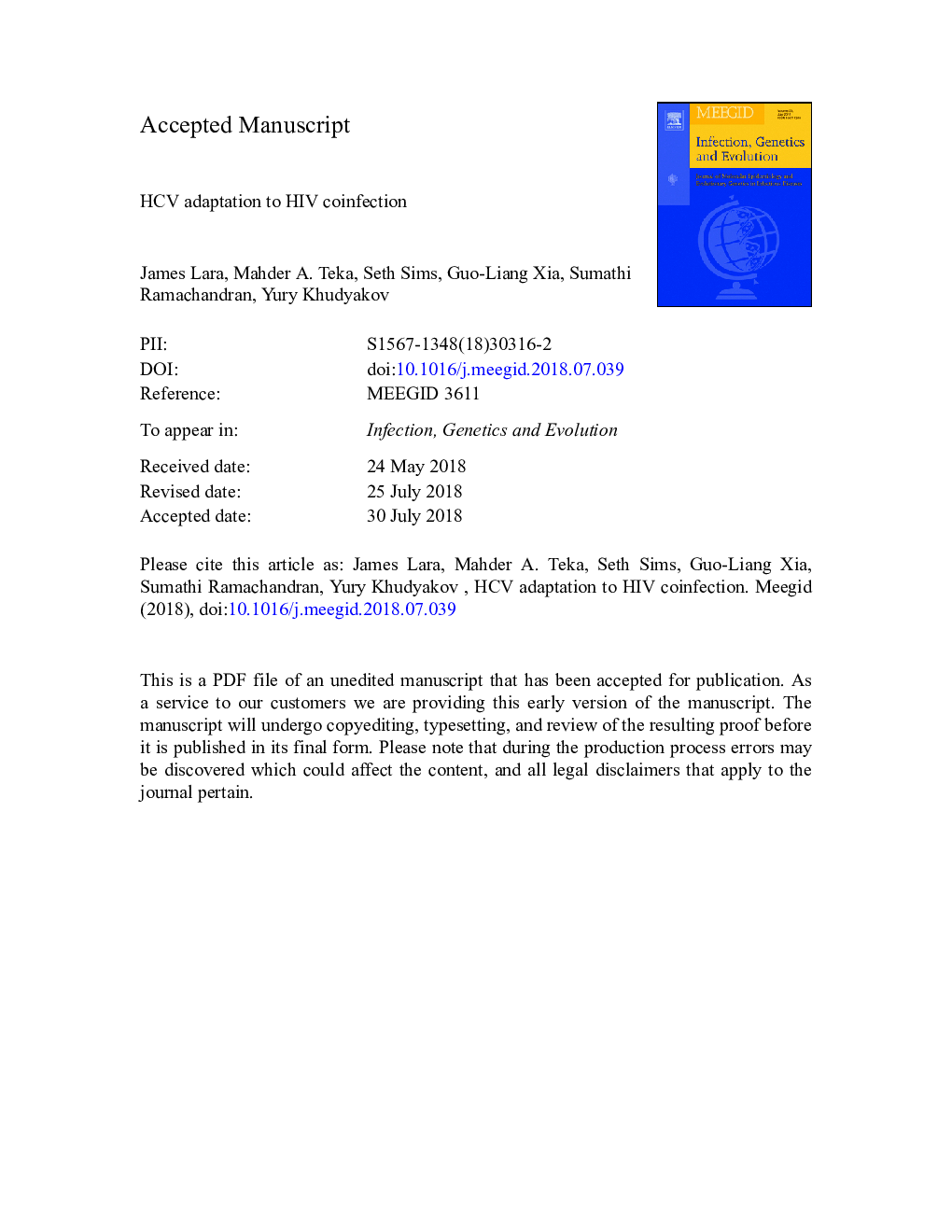| کد مقاله | کد نشریه | سال انتشار | مقاله انگلیسی | نسخه تمام متن |
|---|---|---|---|---|
| 8646504 | 1570138 | 2018 | 28 صفحه PDF | دانلود رایگان |
عنوان انگلیسی مقاله ISI
HCV adaptation to HIV coinfection
دانلود مقاله + سفارش ترجمه
دانلود مقاله ISI انگلیسی
رایگان برای ایرانیان
کلمات کلیدی
موضوعات مرتبط
علوم زیستی و بیوفناوری
علوم کشاورزی و بیولوژیک
بوم شناسی، تکامل، رفتار و سامانه شناسی
پیش نمایش صفحه اول مقاله

چکیده انگلیسی
Human immunodeficiency virus (HIV) infection is rising as a leading cause of morbidity and mortality among hepatitis C virus (HCV)-infected patients. Both viruses interact in co-infected hosts, which may affect their intra-host evolution, potentially leading to differing genetic composition of viral populations in co-infected (CIP) and mono-infected (MIP) patients. Here, we investigate genetic differences between intra-host variants of the HCV hypervariable region 1 (HVR1) sampled from CIP and MIP. Nucleotide (nt) sequences of intra-host HCV HVR1 variants (Nâ¯=â¯28,622) obtained from CIP (Nâ¯=â¯112) and MIP (nâ¯=â¯176) were represented using 148 physical-chemical (PhyChem) indexes of DNA nt dimers. Significant (pâ¯<â¯.0001) differences in the means and frequency distributions of 7 PhyChem properties were found between HVR1 variants from both groups. Linear projection analysis of 29 PhyChem features extracted from such PhyChem properties showed that the CIP and MIP HVR1 variants have a distinct distribution in the modeled 2D-space, with only ~1.3% of PhyChem profiles (Nâ¯=â¯6782), shared by all HVR1 variants, being found in both groups. Probabilistic neural network (PNN) and naïve Bayesian (NB) classifiers trained on the PhyChem features accurately classified HVR1 variants by the group in cross-validation experiments (AUROCâ¯â¥â¯0.96). Similarly, both models showed a high accuracy (AUROCâ¯â¥â¯0.95) when evaluated on a test dataset of HVR1 sequences obtained from 10 patients, data from whom were not used for model building. Both models performed at the expected lower accuracy on randomly labeled datasets in cross-validation experiments (AUROCâ¯=â¯0.50). The random-label trained PNN showed a similar drop in accuracy on the test dataset (AUROCâ¯=â¯0.48), indicating that the detected associations were unlikely due to random correlations. Marked differences in genetic composition of HCV HVR1 variants sampled from CIP and MIP suggest differing intra-host HCV evolution in the presence of HIV infection. PhyChem features identified here may be used for detection of HIV infection from intra-host HCV variants alone in co-infected patients, thus facilitating monitoring for HIV introduction to high-risk populations with high HCV prevalence.
ناشر
Database: Elsevier - ScienceDirect (ساینس دایرکت)
Journal: Infection, Genetics and Evolution - Volume 65, November 2018, Pages 216-225
Journal: Infection, Genetics and Evolution - Volume 65, November 2018, Pages 216-225
نویسندگان
James Lara, Mahder A. Teka, Seth Sims, Guo-Liang Xia, Sumathi Ramachandran, Yury Khudyakov,